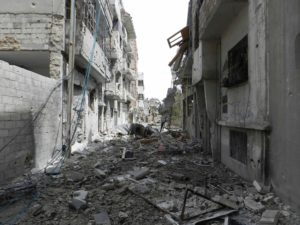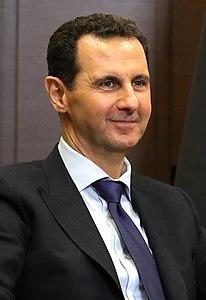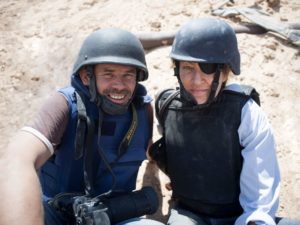
Recently the school brought us to watch a documentary film called “Under the Wire” to let us know more about what’s going on in the world. We found this activity really interesting and useful and for this reason we’d like to tell you about it and especially about the female protagonist of the film, the American journalist Marie Colvin.
The other main protagonist of this documentary along with Marie Colvin, a war journalist of The Sunday Times, is the photo reporter Paul Conroy; the two of them entered Syria illegally in February of 2012.
They wanted to report on the tragedy and sufferings of the civilians, who were stuck in Homs, because Homs was the capital of the revolution against the regime of Bashar Al-Assad.
The conflict began after the murders of 10 Syrian Army soldiers at a checkpoint and the capture of another 19 soldiers by the Free Syrian Army; government forces began an artillery bombardment on the city of Homs on the night of 3rd February 2012.

Marie Colvin and her team had the ambition to show the world what was happening to the civilians, because no one was taking care of them, except one of the doctors in Homs, who uploaded videos on YouTube about the plight of the civilians.
After crossing a long tunnel at night to reach Baba Amr, Marie and Paul met their contact who would translate for them during their stay.
Thus began their work to learn something more of this town relentlessly bombarded by Assad's forces.
In this city they found no soldiers, instead families, women, children and civilians of all ages who had lost friends and relatives.

People were being forgotten by the whole world, they were desperate because no one was worrying about them, no help was coming from outside; it was as if this part of the world wasn’t part of it, and in a sense it is still like that.
Marie could not accept the situation and despite the many dangers, she was more than willing to get to the bottom of the matter, refusing to leave the city with Paul: their documentary is based on what they saw and listened to from the victims of this massacre.
They also filmed the hard work that was going on in the emergency room, where a doctor tirelessly continued to help those who were injured. Unfortunately he couldn't do much because he couldn't get to a hospital, he had to get by with what he had.
However, this was not enough for Marie, she wanted to see the armed conflict even more closely and so she and her team changed positions and they settled in another media center in Homs.

Here they met another group of journalists, including the French journalist Edith Bouvier and the photographer Rémi Ochlik.
Unfortunately their collaboration would not last long, since on February 22nd 2012 an air raid hit the post and killed Marie and Rèmi who were trying to leave the media center .
Marie was 56 while Rèmi was due to be 29. In the attack, Edith and Paul were also injured, in particular the French journalist risked her life because her injury was quite serious and there was no one who could help her .
After many difficulties, Paul and Edith were able to return home to receive adequate care and it is thanks to this that today we can learn more about the story of this extraordinary woman.
A woman who had the courage and tenacity to remain in a foreign land during a war, to learn about it and allowed the whole world to realize what was going on in that part of the world.
In the beginning it was thought it had been an attack like the others in the city, with no intentional purpose against them.
Recently "The Guardian" has published an article reporting that the US Supreme Court decreed that the death of Marie Colvin was not a tragic accident, but a planned murder, she was deliberately targeted.
The newspaper reports the words of Judge Amy Berman Jackson of the US District Court in Washington DC, in which she explains that Marie Colvin was killed for the work she was doing: the Assad regime wanted to prevent her from publishing what she had witnessed, using murder as censorship.
However, despite her death, the Assad government has somehow failed: thanks to her work and the testimony of her colleagues, we all know what happened and we are aware of what happened then and still is now.
This journalist continues to be a source of inspiration for all war correspondents who really want to denounce the atrocities that take place all over the world and it should be so not just for them, but also for us.

We must take our responsibilities and be aware that it is our right to freely express our thoughts, without being afraid of censorship or even of being hurt badly like in the case of Marie Colvin.
“Everyone has the right to freely manifest their thoughts through speaking, writing or any other means of communication.
Press can’t be subject neither to authorizations nor to censorship”: this is what article number 21 of the Italian Constitution says.
Freedom of speech and thought is one of the most important elements of our Constitution and it should be applied in every country so that facts like this would decrease.
The young women of our society should follow the example of this wonderful woman and so should do any other woman in the world.
The main lesson we have learned from her is that it doesn’t matter if you are a man or a woman, what matters is how much love and dedication you put in what you are doing and Marie Colvin is a clear example of that.
Nowadays people think that solutions to problems turn up just by waiting for them as if they were miracles: nevertheless any one of us can do something, even if by simply telling about the life of women as brave as Marie Colvin.
References:
- Film: Under the wire (2018), Chris Martin;
- Article: from The Guardian, Marie Colvin verdict gives meaning to her death, by Lindsey Hilsum;
- Article 21 of the Italian Constitution.
(Mattia Lorusso, Ginevra Fabbiani, Linda Fattori e Marika Camagnoni)
Traduzione

Di recente la scuola ci ha portato al cinema a vedere un documentario chiamato ‘Under the Wire’, per informarci su cosa sta succedendo nel mondo.
Abbiamo trovato questa attività molto interessante e utile, e per questo motivo vorremmo raccontare anche a voi qualcosa sul documentario e in particolare sulla protagonista femminile del film, la giornalista statunitense Marie Colvin.
L’altro protagonista assieme a Marie Colvin, una giornalista di guerra del The Sunday Times, è il fotoreporter Paul Conroy; i due entrarono illegalmente in Siria nel febbraio del 2012.
Marie Colvin e Paul Conroy volevano denunciare la tragedia e le sofferenze dei civili che erano bloccati ad Homs, perché Homs era la capitale della rivoluzione contro il regime di Bashar Al-Assad.
Il conflitto iniziò dopo la morte di 10 soldati dell'esercito siriano ad un posto di blocco e la cattura di altri 19 soldati dell’Esercito Siriano Libero; nella notte del 3 febbraio 2012 le forze governative iniziarono un bombardamento di artiglieria sulla città di Homs.
Marie Colvin e il suo team avevano l’ambizione di mostrare al mondo cosa stava succedendo ai civili, perché nessuno si stava prendendo cura di loro, a parte uno dei dottori di Homs, che caricava video su YouTube riguardanti la difficile situazione in cui vivevano i cittadini.
Dopo aver percorso un lungo tunnel durante la notte per raggiungere Baba Amr, Marie e Paul incontrarono il loro contatto, che sarebbe stato il loro interprete durante il soggiorno.
Così incominciò il loro lavoro per conoscere qualcosa di più su questa città bombardata senza sosta dalle forze di Assad.
In questa città non trovarono soldati, bensì famiglie, donne, bambini e civili di tutte le età che avevano perso amici e parenti.
Gli abitanti venivano dimenticati dal mondo intero, erano disperati perché nessuno si stava preoccupando di loro, dall’esterno non stava arrivando nessun aiuto; era come se questa parte di mondo non esistesse , e sotto alcuni aspetti è ancora così.
Marie non riusciva ad accettare la situazione e nonostante i numerosi pericoli, era più che determinata ad andare fino in fondo alla questione, rifiutando di lasciare la città con Paul: il loro documentario è basato su quello che videro e sentirono dalle vittime di questo massacro.
Filmarono anche il duro lavoro portato avanti da un dottore nella stanza adibita alle emergenze che continuava instancabilmente ad aiutare quelli che erano stati feriti.
Sfortunatamente non poteva fare molto perché non riusciva a raggiungere l'ospedale e quindi doveva cavarsela con quello che aveva.
Tuttavia, questo per Marie non era abbastanza, voleva vedere il conflitto armato ancora più da vicino e così lei e il suo team cambiarono posizione e si sistemarono in un'altro media center ad Homs.
Qui incontrarono un altro gruppo di giornalisti, tra cui la giornalista francese Edith Bouvier e il fotoreporter Rémi Ochlik.
Sfortunatamente la loro collaborazione non durò molto, poiché il 22 febbraio 2012 un raid aereo colpì la base e uccise Marie e Rémi mentre stavano cercando di lasciare il media center.
Marie aveva 56 anni, Rémi ne doveva compiere 29.
Nell’attacco anche Edith e Paul vennero feriti, in particolare la giornalista francese rischiò la vita perché la sua ferita era abbastanza grave e non c'era nessuno che potesse aiutarla.
Dopo numerose difficoltà, Paul ed Edith riuscirono a tornare a casa e a ricevere le cure necessarie, ed è grazie a questo se oggi possiamo sapere di più sulla storia di questa donna straordinaria.
Una donna che ha avuto il coraggio e la tenacia di rimanere in un paese straniero durante una guerra, di conoscere e permettere al mondo intero di comprendere cosa stava succedendo in quella parte del mondo.
All’inizio si pensava fosse stato un attacco come gli altri, senza alcun proposito intenzionale contro di loro. Recentemente il “The Guardian” ha pubblicato un articolo riportando il fatto che la Corte Suprema degli Stati Uniti ha decretato che la morte di Marie Colvin non è stato un tragico incidente, ma un assassinio programmato, in quanto la giornalista era un obiettivo intenzionale.
Il giornale riporta le parole del giudice Amy Berman Jackson della Corte distrettuale degli Stati Uniti di Washington, in cui spiega che Marie Colvin è stata uccisa a causa del lavoro che stava svolgendo: il regime di Assad voleva impedirle di raccontare ciò a cui lei aveva assistito usando l’omicidio come censura.
Comunque, nonostante la sua morte, il governo di Assad ha in qualche modo fallito: grazie al lavoro di Marie Colvin e dei suoi colleghi, sappiamo tutti ciò che è successo, e siamo consapevoli di ciò che è stato allora ed è ancora adesso.
Questa giornalista continua a essere una fonte di ispirazione per tutti quei corrispondenti di guerra che vogliono veramente documentare le atrocità che accadono nel mondo, e dovrebbe essere così non solo per loro, ma anche per tutti noi.
Dobbiamo assumerci le nostre difficoltà ed essere consapevoli del fatto che esprimere i nostri pensieri è un nostro diritto, senza essere intimoriti dalla censura oppure di essere duramente colpiti come nel caso di Marie Colvin.
«Tutti hanno diritto di manifestare liberamente il proprio pensiero con la parola, lo scritto e ogni altro mezzo di diffusione. La stampa non può essere soggetta ad autorizzazioni o censure.»
Questo è quello che dice l’articolo n° 21 della Costituzione Italiana. La libertà di espressione e pensiero è uno degli elementi più importanti della nostra Costituzione e dovrebbe essere applicata in ogni paese, cosicché fatti come questo possano diminuire. Le giovani donne della nostra società dovrebbero seguire l’esempio di questa donna straordinaria e così dovrebbe fare ogni altra donna nel mondo.
La lezione più importante che abbiamo appreso da lei è che non importa se sei un uomo o una donna, ciò che importa è quanto amore e passione metti in ciò che stai facendo, e Marie Colvin ne è un chiaro esempio.
Al giorno d’oggi le persone pensano che le soluzioni ai problemi arrivino solo aspettando, come si fa con i miracoli: ciò nonostante ognuno di noi può fare qualcosa, anche semplicemente parlando della vita di una donna così coraggiosa come Marie Colvin.
Fonti:
- Film: Under the Wire (2018), Chris Martin;
- Articolo: da The Guardian, Marie Colvin verdict gives meaning to her death by Lindsey Hilsum;
- Articolo 21 della Costituzione Italiana.
(Mattia Lorusso, Ginevra Fabbiani, Linda Fattori e Marika Camagnoni)







